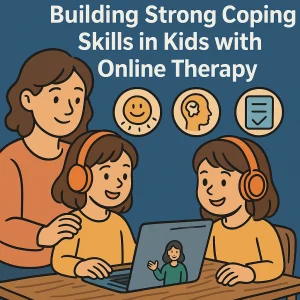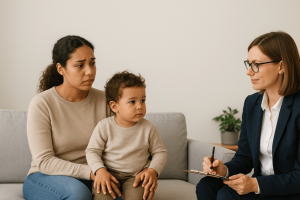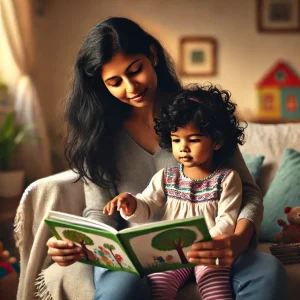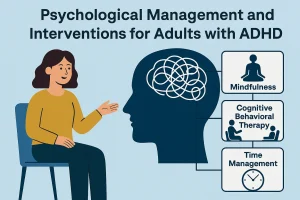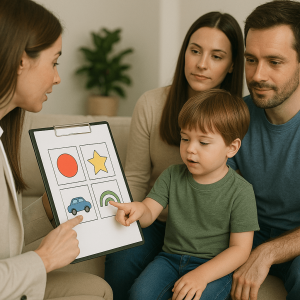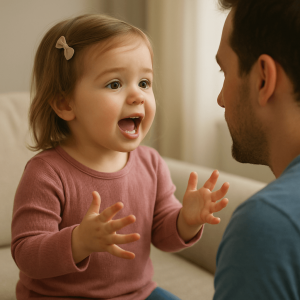How to Teach Self-Regulation to Children: A Simple Guide
Last Updated: October 23, 2024
Have you ever noticed your child struggling to calm down when they’re upset, or maybe they get overwhelmed by big emotions like anger or frustration? This is where self-regulation comes in. Self-regulation is all about teaching kids how to manage their own feelings, thoughts, and behaviors in a healthy way. It’s not just about calming down in the moment; it’s about helping them understand what they’re feeling and finding ways to cope with those emotions on their own. Imagine it as giving your child the tools they need to navigate their own emotional world — tools that they’ll use not just now, but for the rest of their lives.
What is Self-Regulation?
Self-regulation is the ability to manage our emotions, energy, and behaviors in a healthy way. For kids, it means learning how to calm down when they’re upset, stay focused when they’re distracted, or keep going when things get tough. It’s like having a toolbox of strategies to help them handle different situations — whether that’s taking deep breaths, asking for a break, or finding a quiet spot to cool off.
Self-regulation is different from emotional regulation, though they’re closely related. Here’s a simple way to understand the difference:
- Self-Regulation: This is all about controlling energy levels and behaviors. For example, if your child is feeling restless, self-regulation helps them recognize this and choose to do something like stretching or a short walk to calm down.
- Emotional Regulation: This goes a step further by focusing on specific emotions, like anger or sadness. It’s about understanding what they’re feeling and why, then figuring out how to handle those emotions in a healthy way. For instance, if your child feels angry because a game didn’t go their way, emotional regulation helps them express that feeling calmly instead of lashing out.
Self-Regulation vs. Emotional Regulation
| Feature | Self-Regulation | Emotional Regulation |
|---|---|---|
| Focus | Managing overall energy levels and behaviors to stay calm and in control. | Understanding and managing specific emotions like anger, sadness, or frustration. |
| Example | Taking deep breaths, counting to ten, or using a calm-down corner when feeling overwhelmed. | Identifying the reason behind feeling angry or sad and deciding on a healthy way to respond. |
| Skills Involved | Self-awareness of body signals, using calming strategies, and making adjustments to behavior. | Recognizing emotions, evaluating thoughts driving those emotions, and problem-solving emotional responses. |
| Purpose | To maintain a state of balance, focus, and readiness to act appropriately in various situations. | To address and work through emotions, ensuring they are expressed in a healthy and constructive manner. |
| Typical Actions | Engaging in activities like squeezing a stress ball, walking away, or doing physical exercise to reduce energy levels. | Talking about feelings, writing in a journal, or using words to express what’s going on internally. |
| Goal | Achieving a calm and balanced state to handle daily tasks and interactions smoothly. | Expressing emotions in a way that is healthy, allowing for better communication and relationship building. |
Also read: Fun 7 Activities to Boost Emotional Regulation in Young Children
Why Teach Self-Regulation?
Teaching self-regulation to kids is one of the most valuable skills you can offer as a parent or caregiver. It’s not just about keeping calm; it’s about giving your child the tools they need to navigate their emotions and the world around them confidently. Here’s why it matters so much:
1. Helps Kids Stay Calm and Handle Their Emotions
Imagine if your child could calm themselves down when they’re upset, frustrated, or overwhelmed. Self-regulation helps kids recognize their feelings and use strategies to settle themselves, whether that’s taking deep breaths, counting to ten, or finding a quiet spot to relax. This skill is especially helpful in stressful situations, like dealing with a conflict at school or managing disappointment. When kids know how to self-regulate, they feel more in control and less likely to act out, making everyday challenges a little easier to handle.
2. Builds Confidence and Improves Social Skills
Self-regulation doesn’t just keep emotions in check; it also boosts confidence. When kids learn to manage their reactions, they feel more capable and independent. This sense of control can make them more willing to try new things, face challenges, and solve problems without immediately getting frustrated. Plus, self-regulation plays a big role in social situations. Kids who can keep calm and think before they react are better at making friends, sharing, and handling group activities. They can communicate more clearly and are less likely to get into conflicts, which helps them build stronger relationships.
Teaching self-regulation is like giving your child a lifelong toolkit for managing emotions and interactions. It’s about helping them grow into confident, resilient individuals who can handle whatever life throws their way. And remember, it’s a journey — every small step your child takes in learning these skills is a step towards a more balanced and fulfilling life.
Stages of Self-Regulation
Learning self-regulation is a journey that happens in stages. It doesn’t all come at once, and that’s okay! Kids gradually build these skills as they grow, moving from needing a lot of support to handling their emotions on their own. Understanding these stages can help you know how to best support your child along the way.
1. Other-Regulation: When Kids Need Parents to Calm Them
In the early years, children rely heavily on their parents or caregivers to help them calm down. This is known as other-regulation. Think of a baby who cries and is soothed by a hug, rocking, or a gentle voice. At this stage, kids don’t have the skills to calm themselves yet, so they need adults to step in and provide that comfort. It’s all about creating a safe and nurturing environment where your child feels secure enough to let go of their big emotions.
2. Co-Regulation: Working Together to Calm Down
As kids get a little older, they start to enter the co-regulation stage. Here, calming down becomes a team effort between you and your child. You might read a book together, take deep breaths side by side, or have a cuddle on the couch. During co-regulation, you’re still playing an active role, but your child is beginning to participate in calming activities with you. This stage is all about modeling calm behavior and gently guiding your child through the process of managing their emotions.
3. Self-Regulation: Kids Learn to Calm Themselves
The final stage is self-regulation, where kids start to use the skills they’ve learned to calm themselves independently. This might be as simple as a child taking a break when they’re feeling overwhelmed, using a favorite self-soothing strategy like deep breathing, or even choosing to listen to calming music. By the time they reach this stage, kids have a basic toolkit of strategies they can use to manage their emotions without needing constant guidance. It’s a big step towards independence and shows they’re developing the ability to handle their emotions in a healthy way.
Also read: Supporting Emotional Regulation in Kids: Simple Ways to Help
Easy Self-Regulation Techniques for Kids
Helping your child learn self-regulation doesn’t have to be complicated. There are simple and effective techniques that can make a big difference in how they handle their emotions. Here are some easy self-regulation techniques you can try at home to help your child stay calm and in control.
1. Breathing Exercises: Deep Breaths to Calm Down
One of the simplest ways to help your child calm down is through breathing exercises. Deep breathing helps slow the heart rate, reduces stress, and sends a signal to the brain that it’s time to relax. You can try fun techniques like “balloon breaths,” where your child pretends to inflate a big balloon in their belly, or “dragon breaths,” where they breathe in deeply through the nose and blow out slowly like a dragon blowing out fire. These exercises are not only effective but also easy for kids to remember and use whenever they need a quick reset.
2. Sensory Activities: Soft Toys, Music, or Coloring
Engaging your child’s senses is another great way to help them self-regulate. Sensory activities like playing with soft toys, listening to calming music, or coloring can provide the comfort and distraction they need to calm down. For example, having a soft, squishy toy to squeeze can help release tension, while listening to their favorite soothing songs can create a calming environment. Coloring is not just fun but also therapeutic, allowing kids to express themselves creatively and focus on something positive. You can easily set up a small sensory toolkit with these items that your child can access whenever they feel overwhelmed.
3. Create a Calm Space: A Quiet Spot at Home
Creating a designated calm space at home can provide your child with a go-to spot when they need to decompress. This doesn’t have to be anything fancy — a cozy corner with some pillows, a favorite blanket, and a few calming items like books or soft lighting can do the trick. Encourage your child to use this space when they feel upset, angry, or just need a break. It’s their personal space to relax and gather themselves, free from distractions and stress. This calm corner becomes a safe haven where your child can practice self-regulation in a comfortable and familiar setting.
Also read: Emotional Regulation Tips for Children with Autism and ADHD
Tips for Parents
Teaching your child self-regulation is a journey that involves patience, consistency, and support. As a parent, you play a crucial role in guiding your child through this process. Here are some practical tips to help you along the way:
1. Be a Role Model: Show Kids How You Manage Your Emotions
Children learn a lot by watching the adults around them. When you handle your own emotions calmly, it shows your child how to do the same. For example, if you’re feeling stressed, you might say, “I’m feeling a bit overwhelmed right now, so I’m going to take a few deep breaths to calm down.” By narrating your actions and showing them in real-time, you’re modeling self-regulation techniques that your child can mimic. Remember, kids are always observing, so demonstrating healthy ways to manage stress or frustration teaches them valuable skills they can use too.
2. Positive Reinforcement: Praise Kids When They Use Self-Regulation Techniques
Positive reinforcement goes a long way in encouraging your child to continue using self-regulation strategies. Whenever you see your child successfully calming themselves down or making a good choice in a tough situation, let them know you noticed. A simple phrase like, “I saw how you took deep breaths when you were upset — that was a great way to handle your feelings!” can boost their confidence and reinforce the behavior. The goal is to make self-regulation a habit that feels rewarding, not a chore.
3. Stay Patient: Learning Self-Regulation Takes Time
It’s important to remember that learning self-regulation is a gradual process, and it’s normal for kids to have setbacks along the way. Stay patient and supportive, even when things don’t go perfectly. Some days will be easier than others, and that’s okay. Encourage your child to keep trying, and remind them that it’s okay to feel big emotions. It’s the effort to manage those emotions that counts. Your patience shows them that learning these skills is a journey, not a race, and that making mistakes is just part of growing.
Overcoming Challenges
It’s normal for kids to resist or struggle with self-regulation, especially when they’re just starting to learn. Sometimes, the very techniques meant to help them calm down can feel frustrating or unfamiliar. Here are some practical ways to handle these challenges and gently encourage your child to try different self-regulation techniques.
What to Do If Kids Resist or Have Trouble Calming Down
When your child resists calming techniques, it’s easy to feel stuck. The first step is to stay calm yourself, as your response sets the tone for theirs. If they push back on suggestions like deep breathing or taking a break, it’s helpful to validate their feelings first. You might say, “I see that you’re really upset right now. It’s okay to feel this way.” Acknowledging their emotions makes them feel heard and understood, which can often reduce resistance.
Next, try offering choices. Children feel more in control when they have options. Instead of saying, “You need to calm down,” you could ask, “Would you like to take deep breaths with me, or would you rather sit with your favorite toy for a bit?” This approach not only gives them a sense of ownership over their actions but also gently nudges them towards self-regulation without making them feel forced.
Simple Ways to Encourage Them to Try Different Techniques
Encouraging your child to try new self-regulation techniques can be made fun and engaging. One way to do this is by turning these activities into a game or a challenge. For example, you can have a “Calm Down Countdown,” where your child practices different techniques for a few seconds each. You could also create a “Calm Jar” filled with slips of paper, each listing a different self-regulation strategy, and let them pick one to try.
Positive reinforcement is key. When your child successfully tries a new technique, no matter how small the effort, acknowledge it. A simple “Great job taking those deep breaths!” or “I’m proud of you for trying something new” goes a long way. The goal is to make self-regulation feel rewarding, not like a task they have to do.
Quick Tips for Overcoming Challenges
| Challenge | Simple Solution |
|---|---|
| Resistance: Child refuses to calm down | Offer choices, such as asking if they prefer deep breathing or a quiet activity. Validate their feelings by saying, “I see you’re upset, and that’s okay.” |
| Frustration with Techniques: Techniques feel boring | Turn the techniques into a game or challenge. For example, make deep breathing a “dragon breath” contest or use a timer to make it a fun race. |
| Lack of Engagement: Child isn’t interested | Introduce self-regulation techniques during calm moments, not just when they’re upset. This makes the strategies feel less like a task and more like part of their routine. |
| Overwhelmed by Choices: Too many options can be confusing | Simplify by offering just two choices, such as “Would you like to squeeze this ball or color quietly?” This keeps it manageable and less overwhelming. |
| Inconsistent Practice: Techniques not used regularly | Create a visual routine or checklist with calming activities that your child can pick from daily, making practice consistent and engaging. |
| Fear of Trying New Things: Child hesitates to try new techniques | Demonstrate the technique yourself first and invite them to join in once they see how it works. Use positive reinforcement to encourage participation. |
The Role of Parents and Caregivers
As a parent or caregiver, your role in teaching your child self-regulation is incredibly important. You are not just a guide but also a source of comfort and safety. Your gentle support can make all the difference in helping your child feel secure as they learn to manage their emotions. Here are some simple ways you can support your child through this journey:
Support Your Child by Guiding Them Gently
Children thrive when they feel understood and supported, especially when they’re learning new skills like self-regulation. Instead of telling your child what to do, guide them gently through the process. For instance, if your child is upset, rather than saying, “Calm down,” try saying, “I’m here with you. Let’s take some deep breaths together.” This approach shows empathy and helps your child feel that they are not alone in their struggle.
Your presence and guidance can help turn moments of frustration into opportunities for learning. For example, if your child has a meltdown, calmly guide them to a quiet spot or suggest a familiar calming activity like squeezing a favorite toy or listening to soothing music. By staying close and offering gentle suggestions, you provide a steady anchor that helps your child navigate their emotions more easily.
Use Calm Words and Actions to Help Them Feel Safe
Kids are highly sensitive to the tone of voice and body language of those around them. When you use calm words and actions, it signals to your child that everything is okay and that they are safe. Even in stressful moments, try to keep your voice soft and your movements slow and deliberate. This doesn’t mean suppressing your own feelings but showing your child how to handle emotions calmly.
For instance, if your child is overwhelmed, you might say, “It’s okay to feel upset. Let’s figure this out together.” This reassurance helps create a sense of safety and trust, making it easier for your child to follow your lead. Consistently using a calm approach teaches your child that they can rely on you for stability, which is crucial for developing their own self-regulation skills.
Mention of Wellness Hub
As you continue supporting your child in learning self-regulation, remember that you don’t have to do it alone. Every child is unique, and finding the right strategies can sometimes be challenging. That’s where Wellness Hub can be a valuable resource. We offer expert advice, tailored tips, and a variety of supportive tools designed to help both parents and children navigate the journey of building self-regulation skills.
Conclusion
Teaching self-regulation to your child is a gradual journey that requires time, patience, and small steps. It’s important to remember that it’s not about getting everything perfect right away but about making steady progress. Every time your child takes a deep breath to calm down, tries a new technique, or simply recognizes their feelings, they are learning and growing. These small actions might seem minor, but they add up to big improvements in how your child manages emotions and handles challenges.
As a parent, your gentle support and encouragement make a huge difference. Celebrate the little wins and remind your child that it’s okay to make mistakes along the way. Self-regulation is a skill that takes practice, and even adults are always working on it! Keep guiding your child with patience, and remember that resources like Wellness Hub are here to help with tips and support whenever you need it. Every small effort you make today is helping your child build a brighter, more balanced future.
Frequently Asked Questions:
1. What is self-regulation in children?
Self-regulation is the ability of children to manage their emotions, behaviors, and energy levels. It helps them calm down when upset, stay focused when distracted, and respond thoughtfully instead of impulsively. Teaching self-regulation skills is crucial for a child’s emotional and social development.
2. How can I teach my child self-regulation skills?
You can teach self-regulation by modeling calm behavior, practicing deep breathing exercises, creating a calm space at home, and using sensory activities like playing with soft toys or listening to soothing music. Start with simple techniques and practice them regularly in calm moments.
3. Why is self-regulation important for kids?
Self-regulation helps kids stay calm, handle their emotions, and make better decisions. It builds confidence, improves social skills, and allows children to navigate everyday challenges more effectively, leading to better relationships and overall well-being.
4. What are some self-regulation techniques for children?
Some effective self-regulation techniques for children include deep breathing exercises, using a calm space, sensory activities like coloring or playing with soft toys, and practicing co-regulation with a parent or caregiver. These techniques help kids learn to manage their emotions and behaviors.
5. How can parents support their children in learning self-regulation?
Parents can support their children by guiding them gently, using calm words and actions, and being patient as their child learns these skills. Positive reinforcement, such as praising the child when they use self-regulation techniques, can also encourage continued practice.
6. What should I do if my child resists calming down?
If your child resists calming down, try validating their feelings and offering choices. For example, ask if they’d prefer to take deep breaths or sit with a favorite toy. The key is to stay calm yourself and guide them without forcing any specific action, making the process feel more like a choice rather than a demand.
7. How does self-regulation differ from emotional regulation?
Self-regulation involves managing overall energy and arousal levels, while emotional regulation focuses specifically on understanding and managing emotions like anger or sadness. Both skills are important and work together to help children handle their emotions and behaviors effectively.
8. At what age do kids start to learn self-regulation?
Kids begin learning self-regulation in stages: they start with other-regulation, where they rely on parents to calm them, move to co-regulation, where they learn to calm down with the help of parents, and finally, develop self-regulation skills to calm themselves independently, typically by age six.
9. How long does it take for a child to learn self-regulation?
Learning self-regulation is a gradual process, and every child is different. It can take time, and children often go through ups and downs as they practice these skills. Consistent guidance, patience, and positive reinforcement from parents are key to helping children build self-regulation over time.
10. Where can I find more resources to help my child with self-regulation?
For more tips, personalized advice, and resources on teaching self-regulation to kids, visit Wellness Hub. Wellness Hub offers expert insights and practical tools to support you and your child in developing these essential skills.
About Author:
Lasya Vooturi,
Clinical Psychologist (A) & Behavioral Therapist
Lasya holds a Professional Diploma in Clinical Psychology from Amity University, where she deepened her understanding of psychological principles from March 2023 to March 2024. With over a year of dedicated experience as a Behavioral Therapist, Lasya has honed her skills in applying effective therapy techniques tailored to individual needs. Fluent in Telugu, Hindi, and English, she is adept at connecting with a diverse range of clients, ensuring comprehensive communication and understanding. Lasya’s approach is grounded in empathy and scientific rigor, making her a trusted ally in navigating mental health challenges.
Book your Free Consultation Today
Parent/Caregiver Info:
Client’s Details:
* Error Message
